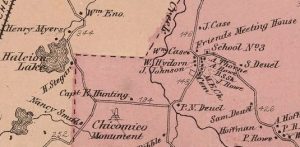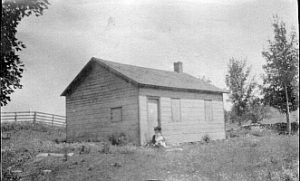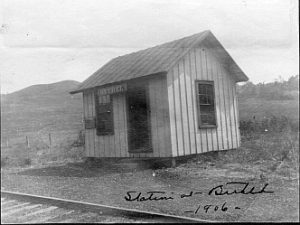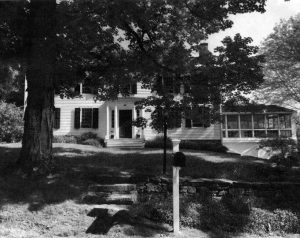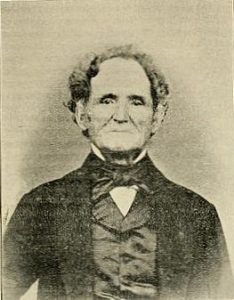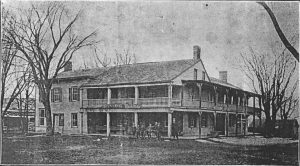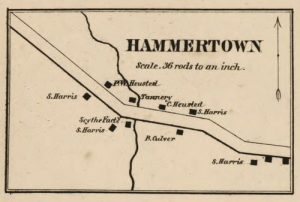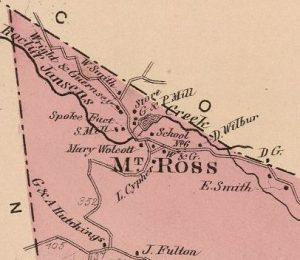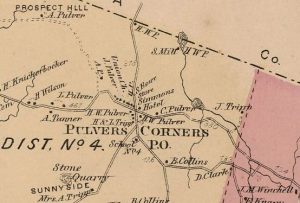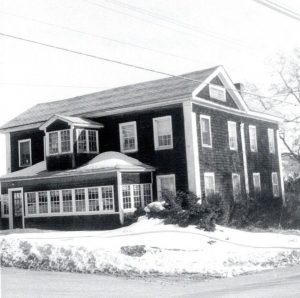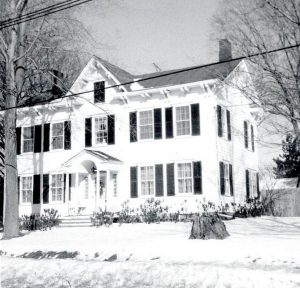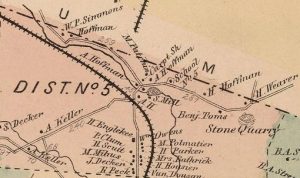Bethel: Located about 2 miles south of the Pine Plains hamlet on Carpenter Hill Road, then continuing south over the Shekomeko Creek to Bethel Cross and Strever Farm Roads, this encompassed Lots 12, 13, and 30 in the partition of the Little Nine Partners Patent. Lot 12 was the location of the Moravian mission and Mahican village of Shekomeko, and because the first church and school were established here at the mission, Bethel is considered the first settlement of Pine Plains. In addition to the conflicts over the Indian land, a section of Lot 12, called "The Gore", was disputed territory between the patentees of the Little Nine and the Great Nine, with the Great Nine patentees claiming half of these lots as their northern border. The rest of the hamlet fell into Lot 30 which bounded Lot 12 on the north.
(see "The Moravian Mission at Shekomeko" page)
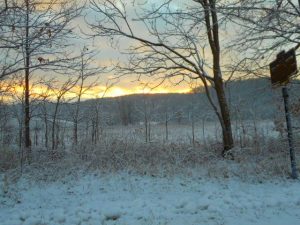
The hamlet was named for the Bethel Union Church (1839-ca. 1920), which was preceded by two Lutheran churches, Old Round Top (1746-1780), and Round Top (1780-1827). All that remains of these churches are the old burying grounds on either side of Carpenter Hill Road.
One of the earliest European settlers of this area of whom we have any record was John Rowe (Johannes Rau), a Palatine who had settled on Halcyon Lake near the Shekomeko village before 1740. It was here in his "long house" that the Moravian missionary Christian Henry Rauch lived briefly before moving in with the Indians at Shekomeko and establishing the mission. Rowe also provided lodging for Charles Clinton and his corps of surveyors at the time of the patent surveys in 1743. Rowe got along well with the Shekomeko Indians and his daughter Jeannette, who later married missionary Martin Mack, was fluent in the native language.
Michael Rowe, thought by some to have been John's brother, was instrumental in establishing the Round Top Church here, and the Rowe Cemetery on the east side of the road through the hamlet was set aside for his descendants. This section of Carpenter Hill Road is sometimes called Bethel Road.
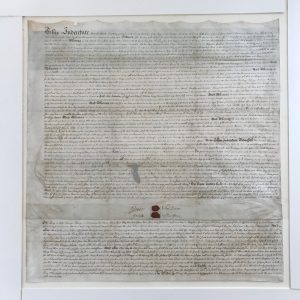
Another early resident of the hamlet who bears mentioning was John Tice (sometimes written as Hontice) Smith, also a Palatine and founder of the Round Top Church. In 1741 he purchased 300 acres of what would become Lot 12 in the partition from Captain Richard Sackett, a Little Nine partner. One of the interesting things about this transaction is that the deed exempts the Indian village from the purchase. The other interesting thing is that because this was before the patent survey the purchase did not hold, and at the time of the partition Smith was forced to give up this parcel and in 1749 purchased other land in Lot 12 for 250 pounds. The historical society is in possession of the actual vellum deed for this second parcel (see insert), which he purchased from Isaac Van Dam (an assignee of original partner Robert Lurting) and Isaac's wife Isabella; this later became the Phoenix Deuel farm (P.N. Deuel on the map below).
(see "People" and "Churches" pages)
At one time the hamlet had its own post office, schoolhouse (see inset), a blacksmith shop, a shoemaker, a steel shop, a carding mill, and a train station (see inset). However, in addition to the Moravian mission, the location of a Quaker (Friends) Meeting House and boarding school here set Bethel apart from the other hamlets in Pine Plains (see "Churches" page for more about Charles Hoag and the Quaker presence in Bethel). This was also the site of Barn B of Briarcliff Farms (see "Briarcliff Farms and its Successors" page).
The hamlet retains much of its rural character from over two hundred years ago, with a few road changes. Bethel Cross Road was laid out in 1805, connecting Carpenter Hill Road with the Pine Plains-Stanford Road (Strever Farm Road today). Before this "shortcut", a winding road ran from the Charles Hoag residence at the end of Carpenter Hill Road westerly then southwesterly until it came out on the Pine Plains-Stanford Road, near where the intersection of Bethel Cross Road and Strever Farm Road is today. In 1919 the Pine Plains-Amenia Road was straightened at the intersection with Carpenter Hill Road (the fork at the end of Carpenter Hill Road being the original highway), and the Pine Plains-Standford Road was straightened with the portion of the highway that was cut-off in this process becoming Strever Farm Road.

The Norway maples that line Bethel Cross Road and Strever Farm Road create one of the most spectacular fall foliage displays in all of Pine Plains.
In 1769, James Winans (1715-1795), a Quaker, purchased 150 acres of the northwest corner of Lot 12 for 300 pounds, and in 1774 he and his sons built this homestead here, known today as the Winans-Huntting House. This property included the portion of Lot 12 which was the site of Shekomeko and the mission.
Both James and his sons were patriots in the Revolution and James had signed the Articles of Association, a protest against the English government. Gerardus Winans (1747-1826), son of James, inherited the property from his father. In 1797, Gerardus became one of the original 47 subscribers to the Union Library of Pine Plains, and in 1803 he helped found the Quaker Meeting at Bethel, however he was expelled because he had married a non-Quaker. This was just one of the religious controversies that would befall the hamlet. After Gerardus died the farm was purchased by Isaac Huntting VI for his son Edward. The two families became related when Edward, son of Isaac, married Amanda Winans who was Gerardus Winans' niece.
Edward Huntting (1797-1884) was influential in getting the Moravian monument dedicated here in 1859. The Hunttings were a musical family, and the piano Edward purchased for his daughters was the first piano in the town of Pine Plains. He was the father of the Pine Plains historian, Isaac Huntting. The property remained in the Huntting family until 1904 and later became part of Briarcliff Farms. The house has been placed on the National Register.
Another early dwelling located on Lot 12 of the patent which also became part of Briarcliff Farms was the Sheldon Strever Farm on Strever Farm Road (the old Stanford-Pine Plains Road). This house is the closest to the former Shekomeko village and mission site. The earliest owner of this property that we know of was a Stephen Cumming in 1790, but the house could be older.
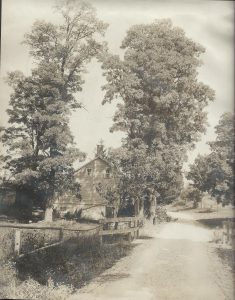

Sources:
History of the Little Nine Partners, by Isaac Huntting, Chas. Walsh & Co., Amenia, NY, 1897
Out of the Wilderness, a LNPHS publication, 1996
"Biographical Sketches of James Winans and Gerardus Winans", by Winslow E. Winans, La Jolla, California, 1985, donated to LNPHS by Bernadette Murray.
Suggested Further Reading:
"Dear Children in Wisconsin", letters from Peter Hidorn, the Bethel blacksmith, and his wife Catherine, to their son and daughter-in-law who had emigrated to Wisconsin in the 1850s hoping for a better life.
Pine Plains: The area that became the hamlet of Pine Plains had been Lots 29, 47, and 48 of the Little Nine Partners Patent. Because of its centralized location within the patent boundaries, the seat of government for North East Precinct (a forerunner of North East Town, formed in 1788) was located here after that administrative body was formed in 1746. It was probably inevitable, then, that "the pine plains" (named for all the pine trees that once covered the glacial outwash plain at the foot of Stissing Mountain) would soon overtake Bethel as the town center.
The town record books from this period give us a window into how much of a wilderness this was, with the following entry from April 7, 1795: "Voted that 6 pounds bounty be paid by tax on the inhabitants of this town for every wolf's head that is killed in said town in the year 1795". Also from around the same time, "Voted, that all hogs have a right to run on the common if ringed and yoked."
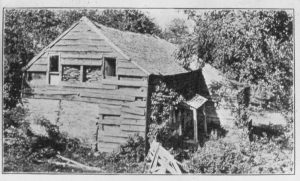
The first establishments in the hamlet were taverns and trading posts. In those days, taverns were community centers. Town business was often held there and the proprietor was often a leader in the community. The Stewart-Kellar House, about 1 mile west of the hamlet center near Ryan Road today, was the first tavern in Pine Plains and the location for North East Precinct meetings and elections from 1774-1792. The proprietor, James Young, was constable for the middle district of the precinct (i.e. Pine Plains) and a signer of the Articles of Association. This building is long gone.
The Dibblee-Booth House (sometimes called the Booth-Lasher House), originally a 24 ft. x 60 ft. 1-floor log house with 10-12 inch thick square-hewn pine logs, served as an Indian trading post, perhaps the earliest non-native structure in the hamlet. A brick taken from the chimney jam at the time the building was razed in 1878 had a stamp with “1728” on it. It was located on the main road (Route 199 today) three tenths of a mile west of the hamlet.
The Stissing House, originally a log tavern built by Captain Cornelius Elmendorph in 1782, is one of the oldest continuously-operating inns in America. It was leased annually from the heirs of George Clarke (see below). In addition to town meetings and elections being held here, the Union Library of Pine Plains was formed here in 1798 and the Pine Plains Bank (predecessor of Stissing Bank) in 1839.
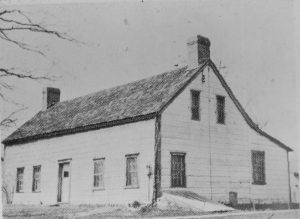
The Graham-Brush House is the earliest building in the Pine Plains hamlet which is still standing, possibly dating back to 1750. It was originally an 18 ft. square 1-floor, 1-room log structure which may have been built as a surveyor's cottage, since it was on Graham land and Augustine Graham was Surveyor General of the Provence of New York. His grandson, Lewis Graham, was the first known inhabitant around the time of the American Revolution. The building is now a museum owned by the historical society and serves as its headquarters.
Since building and maintaining good roads are essential to promoting settlement, the laying out in 1785 of what became Church Street no doubt facilitated the hamlet's growth. In 1802 this road would become a segment of the Salisbury Turnpike (Route 199 today) which ran from the Connecticut border, across the Hudson River by ferry, and continued all the way to Bainbridge, New York. It was part of the old Indian trail which had been the route the Moravian Missionaries took in their travels to and from Bethlehem, Pennsylvania. This turnpike and the Ancram Turnpike just to the north competed for trade and travel until the Salisbury Turnpike became the predominant route.
A district school was established in the hamlet in 1795, and a select school was run by Miss Sarah Allerton, the daughter of the local doctor, out of her home in Pine Plains for a few years until her death in 1859.
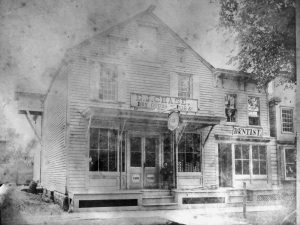
By the early 1800s, merchants had begun to set up small shops along the turnpike, and where Graham Lots 29 and 48 were situated, the land was gradually subdivided and sold off, allowing growth to flourish. However, there was virtually no development of Lot 47 which was located on the west side of Main Street both north and south of the intersection. This lot was owned by George Clarke and his heirs from 1741 until 1895 and held as leaseholds for that entire time. George Clarke had been appointed Secretary of the Province of New York in 1703, and was the acting Governor from 1736-1743.

In 1797 the first Pine Plains mail route was introduced by local resident Israel Reynolds and Alexander Neeley from Amenia at their own expense. This ran “from Rhinebeck by North East [Pine Plains hamlet] and Amenia to Sharon”. In 1818 the federal post office was finally able to take it over. The Pine Plains Post Office was officially named in 1819, four years before the town of Pine Plains was incorporated in 1823. Local postmasters were political appointments so the position changed every time a new political party was elected in Washington (until the post office was reorganized in 1971).
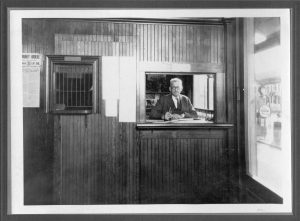
In 1830, the road from Pine Plains to Poughkeepsie, called the "long route" (Route 82 today), was laid out and a stage coach with a 4-horse team transported passengers and mail two times per week, later three times, until the Harlem Railroad in 1852 made Millerton the principle point of mail and commerce. This was a rough road and would not be paved or straightened until the 1930s.
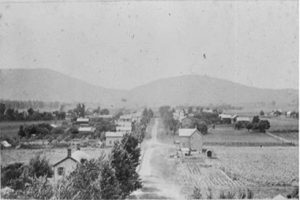
Apparently, Pine Plains had somewhat of a wild reputation back in those days. In his 1873 sermon commemorating his fifty-year pastorate at the Presbyterian church, Rev. William N. Sayre notes that in 1833, "the Sabbath was but little regarded by the people generally in this region, and the various kinds of sports and gaming were quite prevalent on God's holy day...Pine Plains at that time had a reputation abroad--but the name was associated with horse-racing, rum-drinking, gambling, man-fighting, and irreligion."
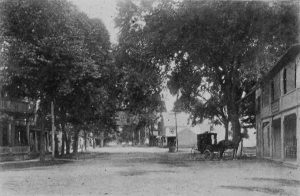
On the eve of the Civil War, the hamlet was a thriving community (and presumably somewhat tamed). The Union Library of Pine Plains was established in 1798; the Pine Plains Bank in 1839; and the first newspaper, The Pine Plains Herald, in 1859. A town cemetery, Evergreen Cemetery, was laid out in 1852.
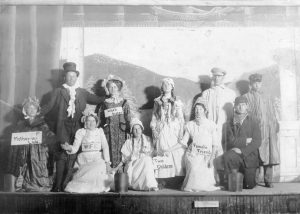
After the war the railroads brought further growth, beginning with the Poughkeepsie & Eastern and the Dutchess & Columbia, both commissioned in 1866.
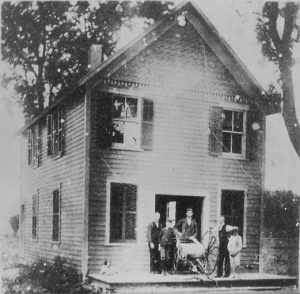
By the turn of the 20th century, the hamlet had a lamp district (kerosene), a water works and a fire company. The railroads supported entertainment venues like the Bowman Opera House and Memorial Hall, as well as a roller-skating rink that young people flocked to from all over the county in the 1880s. Students used the train to commute to Seymour Smith Institute (later Seymour Smith Academy). By the end of 1921, most of the hamlet had electric power, the current being carried about 9 miles from Millerton and requiring 343 poles.
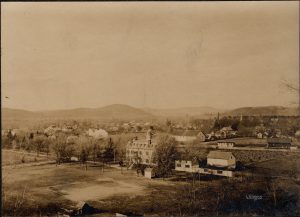
In the summers the boarding houses in the hamlet were full of tourists brought by the trains, and deluxe accommodations like The Pines and Crystal Lodge prospered. The trains brought salesmen to Pine Plains every Wednesday, where they would hang out at the Ketterer Hotel and trade stories.
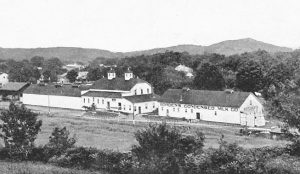
The railroad drew industries like Borden Condensed Milk Company (see inset), Briarcliff Farms just south of the hamlet, and an evaporator for apple drying.
The railroad era ended by the mid-1930s as the introduction of automobiles and buses and the hauling of freight by truck made them obsolete.
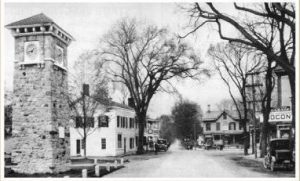
The hamlet of Pine Plains remains the business and civic center of the town to this day.
See our Walking Tour of the Pine Plains Hamlet: "Walking Tour Brochure"
Sources:
History of the Little Nine Partners, by Isaac Huntting, Chas. Walsh & Co., Amenia, NY, 1897
The Pine Plains Register, The Pine Plains Herald, and The Register-Herald
Hammertown: Located about ¾ mile east of the Pine Plains hamlet on the section of Route 199 (Salisbury Turnpike) that was reconstructed and is now Hammertown Road, Hammertown was almost wholly encompassed by Lot 30. It was named for the sound of the trip hammers at the Harris Scythe Works, the most important industry in the town while it lasted (1776-mid 1800s), and was also the location of a tannery (see "Industries Along the Shekomeko" page for more information on these industries).
The story of Hammertown is the story of the Harris and the Husted families. John Harris (1747-1814) settled here after the Revolution and established Harris Scythe Works, having learned the trade at his uncle Joseph Harris' scythe works just south of Pine Plains on the road to Amenia. Married to the former Mary Gamble, he was a founder and trustee of the Union Library of Pine Plains; their son Israel Harris was the first supervisor of Pine Plains in 1823 (see "People" page). Around 1814, Seth Harris, son of Joseph, together with his sons Silas and John, took over the operation of the scythe works, which Silas continued after his father's death (see "People" page for more on Silas Harris).
The Husteds were Huguenots who arrived here in 1796 where they established a tannery on the Shekomeko Creek near the scythe works.
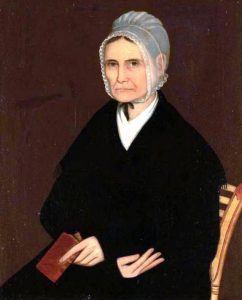
Polly Husted (1761-1825) was the wife of tanner Peter Husted (see "People" page). She was the daughter of Isaac Smith, Esq. This is a copy of her will (see inset).
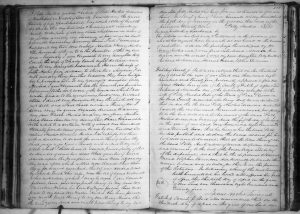
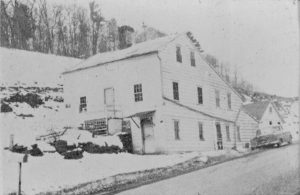
Inevitably, the Harris and Husted families intermarried.
We don’t have an exact date for the construction of the Harris-Husted House, but it was perhaps first occupied by a Philip Snyder, one of the earliest inhabitants of this area, so probably prior to 1800. It has been at various times owned by members of the Harris and Husted families and their combined descendants.
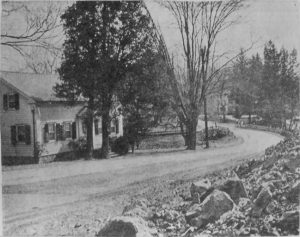
In 1964-1965, Route 199 was set to be reconstructed and the house was in the path of the new highway. Just prior to this, a beautiful Greek Revival in the center of Pine Plains, the Davis house, had been demolished to make way for a Grand Union grocery store. The uproar over this had led to the formation of the Little Nine Partners Historical Society. Now, with another historic building in Pine Plains threatened with destruction, the historical society sought for a way this could be avoided. The estate of Mary D. Slingerland, through its executrices, donated to the historical society a piece of land on the Shekomeko Creek about ¼ of a mile south of the house’s original location. The house was purchased for $1.00 by the historical society and moved to the new location. When the house was moved, the society had to provide a new foundation, baseboard heating system, water supply, and electricity. In 2003 the house was sold to a private individual so that the historical society could focus on the restoration of the Graham-Brush House, one of the earliest surviving structures in the town, which it had acquired in 1997.
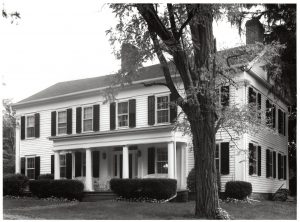
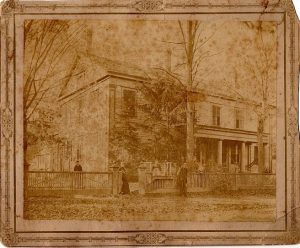
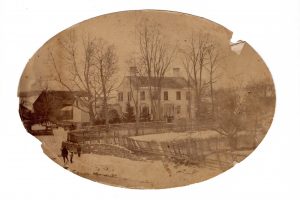
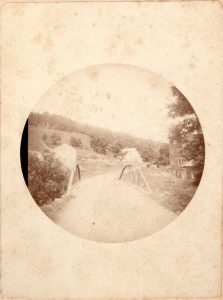
Sources:
History of the Little Nine Partners, by Isaac Huntting, Chas. Walsh & Co., Amenia, NY, 1897
Hammertown, a LNPHS publication, 1968
Mount Ross: Located about 4 miles west of the Pine Plains hamlet on the Jackson Corners-Mount Ross Road, Mt. Ross was covered by Lot 51 of the Little Nine Partners Patent. This hamlet avoided the land troubles that plagued Bethel on Pine Plains' southern boundary, as the land here had been legally purchased from the Mahicans as early as 1697 and there were no subsequent land disputes. The hamlet gets its name from Capt. Thomas Ross (1690-1762), called Baron Ross, but nothing is really known about him.
Like most of the other hamlets in Pine Plains, Mount Ross had its own post office, school, train station, and industries. Situated on the Roeliff Jansen Kill (creek), it is not surprising that many of the industries established here relied on water power: sawmills, grist mills, and fulling mills. There were also the usual small shops: shoemakers, blacksmiths, and coopers. Timbering was predominant, as the forests provided charcoal used in refining lead ore at the Ancram Iron Works nearby.

The last school house here was the Mount Ross School, officially the Bentley Memorial School, erected in 1881 by Henry Bentley in memory of his mother, Hannah Swartwout Bentley, a teacher, at a cost of $3200. It was larger than the average 1-room school house because it was built to be more than just a school, it was a community center. However, shortly after the Pine Plains schools centralized, the school closed. After years of sitting vacant and gradually deteriorating, the school found new life when it was sold to the Dutchess County Fair and moved there in 2004, re-opening as a museum.
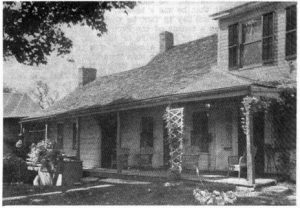
The Melius-Bentley House is the oldest frame house still standing in the town of Pine Plains and has been added to the National Register. The original 1-room square structure was built by Johannes Jacob Melius, a Palatine, between 1710 and 1715. The Melius family apparently moved out of the area around 1790 and it is thought they may have been Loyalists. Between 1790 and 1800, Henry Bentley's grandfather Maj. Henry Bentley (?-1828) took over ownership of the Mount Ross Mills and bought the house, putting on a large Federal-style addition. The house is named for him and Johannes Jacob Melius.
Sources:
History of the Little Nine Partners, by Isaac Huntting, Chas. Walsh & Co., Amenia, NY, 1897
"The Johannes Jacob Melius House at Mt. Ross", by Byrne R. S. Fone, Yearbook of the Dutchess County Historical Society, 1980, Volume 65. This was a talk delivered at the Little Nine Partners Historical Society meeting in June 1980 by Dr. Fone, Town Historian of Pine Plains.
Memories of Mount Ross, a LNPHS publication, 2003
Pulvers Corners: Located about 5½ miles east of the Pine Plains hamlet on Route 199 at the foot of Winchell Mountain, this hamlet was named for the Pulver family and was situated in Lots 32, 33, and 34 of the Little Nine Partners Patent. The Corners now stands at the intersection of two roads, the Salisbury Turnpike (Route 199) and Bean River Road. However, the original settlement was a little to the south of the present corners, and when a new, straighter road was laid in the early 1800s it moved the business center to where it is today. The section of Bean River Road north of the intersection was a portion of the Ancram Turnpike called the Manor Road because it led north to Livingston Manor (Columbia County today).
In 1772, Peter Pulver and his son Wendell, the first Pulvers here, purchased 350 acres from a Joseph Jessup and Joseph Jessup, Jr. for 900 pounds. Like most of the early European settlers of this region, they were Palatines. This was considered the eastern frontier for Palatines migrating eastward from the Hudson River. The Pulvers apparently were Loyalists, since they did not sign the Articles of Association.
William W. Pulver (1773-1861), Wendell's son, is credited with building the hamlet as we know it today. Around 1837 he replaced the old hotel on the northeast corner with the present structure, also a hotel. This was the site of a great deal of political campaigning for Martin Van Buren and William Henry Harrison during the presidential election of 1840, and John Van Buren, son of the candidate, came here to speak on one occasion.
For worship, the earliest inhabitants of the hamlet made the two mile trek west on the turnpike to the Red Church, and then in 1854 a union church was erected in Pulvers Corners, which is still standing but no longer used and in serious disrepair.
Bean River, which runs through the hamlet, is a tributary of the Shekomeko Creek.
Sources:
History of the Little Nine Partners, by Isaac Huntting, Chas. Walsh & Co., Amenia, NY, 1897
Pulvers Corners, a LNPHS publication, 1970
Suggested Further Reading:
"Stanley Pulver is King of Winchell Mountain", an interview with Stanley Pulver in The Register Herald, February 21, 1990
Patchins Mill: As the name suggests, the life of this small hamlet has always revolved around the mill. Located about 2 miles north of the Pine Plains hamlet at the intersection of North Main Street, Silvernails Road, and Hoffman Road, the hamlet was given its current name after Mark A. Patchin bought Hoffman’s Mill in 1873.
The first mention we have of anything on this site is in 1743 when Little Nine Partners Patent surveyor Charles Clinton noted in his field notebook that the stream "had fall fit for a mill". Arabella Graham inherited this property, which fell in Lot 48 of the Little Nine, from her father James Graham, and in 1794, her brother Lewis Graham (of the Graham-Brush House) contributed timber from his sawmill to build the first recorded bridge here.
In 1801, Henry Hoffman (1761-1840), a private in the Revolutionary War and the grandson of a Palatine, purchased the property with his brother Matthias and built the first grist mill on this site, which came to be called Hoffman’s Mill. In 1807 Henry bought out his brother’s share. Besides being a miller, he was a successful merchant and a prosperous farmer, owning 500 acres. Huntting says of Henry that, "from his manhood to the close of his business life, no man in Pine Plains, contemporaneous, had so many business connections with different enterprises all at the same time." He married the former Catherine Veterle.
According to one source, a house was here before the mill, but Huntting says that Henry Hoffman built the "large farm dwelling and barn" here in 1812. It was a story and a half with two large rooms downstairs and the same upstairs. Eight of the ten Patchin children would later be born here.
In 1804 the Ancram Turnpike was laid out, which passed through Hoffman’s Mill on its way from Millerton to the Hudson River eventually connecting Salisbury, Ct. to the Susquehanna River. This was used to transport ore from places like “Hot Ground” (Ancram Lead Mines) to the furnaces at Ancram Iron Works. According to Huntting, Henry Hoffman owned shares in this pike, and for a few years the hamlet benefited from its traffic until the growth of the hamlet of Pine Plains to the south overtook it.

In 1818 a new bridge was built across the creek.
In 1840, Mark Patchin (1819-1894), a millwright, worked on the mill, and while working here he met and married Catherine Ham. In 1873, Mark bought the mill and house from Henry Hoffman’s grandson Anthony Hoffman Jr.
A new iron bridge was installed in 1878 which was replaced by a concrete bridge in the 1930s.
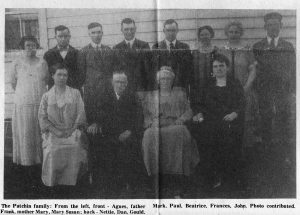
In 1891 heavy spring rains carried the kitchen of the Patchin home off its foundation and a barrel of pork, a "lot of hams", and 2-3 tons of coal went downstream. In 1918 Mother Nature struck again when spring rains washed away the old masonry dam which was about 100 years old, causing Silvernails Road to be flooded under 7-8 ft. of water and even the bridge to be under about 7 ft. of water. The mill building was not affected. A new 75-ft. long concrete dam was constructed that October.
There was also a blacksmith shop in the hamlet, and then in 1938 milk production was started in Gould Patchin's garage. In 1943, a milk plant was constructed. Farmers brought their milk to the plant in cans. The plant had pasteurization and sterilization machinery and also a bottler and a capper. Milk from this plant, as well as cottage cheese, chocolate milk, and buttermilk were delivered to towns all over the area. The plant closed in 1962, and the building is now used as a smokehouse.
(see "Industries Along the Shekomeko" page for more on the mill)
Sources:
History of the Little Nine Partners, by Isaac Huntting, Chas. Walsh & Co., Amenia, NY, 1897
Paper on Patchins Mill in the LNPHS collection, written by Claire Robinson, 1973
Suggested Further Reading:
"At 100 Life is Never Dull for Bea Patchin", an interview in The Register-Herald, September 9 & 10, 1981



